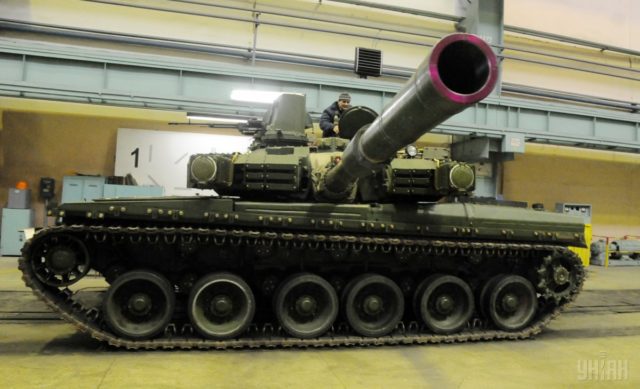
Ukraine Upgrades Military Potential With New Tanks, Missiles
Publication: Eurasia Daily Monitor Volume: 14 Issue: 7
By:

Russia’s military aggression against Ukraine, starting in 2014, has naturally had a galvanizing effect on the Ukrainian military-industrial complex and its potential. According to various sources (see below), this progress has been most apparent in areas including heavy weapons and equipment, production of small arms and light weapons, as well as mobile ballistic missile systems.
Perhaps the most notable advancement has been related to the development of advanced tanks and heavy weapons and equipment. In mid-January 2017, it was declared that Ukraine had completed work on a new type of tank known as the “T-rex,” a transitional, domestically produced, highly modernized improvement on Soviet-era T-64 and T-72 models (Uprom.info, January 12; Euromaidan Press, January 18). Sergey Zgurets, the editor-in-chief of the major Ukrainian military magazine Defense Express, has argued that, in terms of its technical characteristics, the T-rex is “comparable to the most advanced up-to-date tanks produced in the world, including the widely promoted and well-known [T-14] Armata,” being produced by Russia (Korrespondent.net, January 14).
This optimism of Ukrainian (and many international) experts and officials has, of course, been met with scepticism and derisive remarks coming from Russian officials and specialists in the field. For instance, Russian Deputy Prime Minister Dmitry Rogozin declared, via Twitter, that the “military industrial complex of Ukraine has created a new tank made of trash bins”; whereas, the “independent” Russian military expert Alexey Khlopotov suggested that the T-rex tanks should not be taken seriously since Ukraine “does not have the necessary technology and expertise.” According to Khlopotov, Ukraine’s tank development program is “merely about the redistribution of financial means” (Tvzvezda.ru , October 13, 2016). Nonetheless, at the November 2016 International Defense Exhibition and Seminar (IDEAS), in Karachi, many countries from the Middle East, North Africa and Asia (in particular Pakistan) in fact showed great interest in domestically produced Ukrainian tank designs—especially the “Oplot-M” (Military-informant.com , November 28, 2016).
In addition to heavy armor, Ukraine’s military industrial complex has also been making new gains in missile technology. The country plans to replace its Soviet-era Tactical Operational Missile Complex “Tochka-U” (SS-21 “Scarab” in NATO terminology) with more advanced Grom short-range ballistic missiles, built domestically (Sputnik News, August 7, 2016). The Grom is reportedly being developed with the involvement of the Yuzhnoye Design Office (which created the legendary “Satana” missile). Ukraine successfully tested the new surface-to-surface missile several times last year (Interfax-Ukraine, November 16, 2016). According to Ukrainian sources, this weaponry, with a range of 300 kilometers, is more advanced and sophisticated than existing Russian analogues. The tactical ballistic missile’s official range is likely listed at 300 km to fit within the Missile Technology Control Regime for export purposes; but its potential range, if acquired domestically by the Ukrainian military, could be as long as 500 km (Patrioty Ukrainy, January 29, 2016).
Last year, President Petro Poroshenko also announced the development of a stealthy cruise missile, under the project code name “Neptune.” Work in this direction is apparently culminating in a missile named the “Korshun,” but few details are available at this point. The range is said to be 280 km, which again does not mean that this distance could not be extended for domestic use, if procured by the Ukrainian armed forces. In comparison with the Grom, these missiles are significantly smaller and can be fired from the air, including from the Su-27 (NATO designation: “Flanker-B”) fighter jet. Designed for maximum penetrative ability, the Korshun is reportedly able to fly 50 meters below “radar level” and employs stealth technology, making it practically undetectable to contemporary radar systems as it flies toward its target (Patrioty Ukrainy, January 29, 2016). If these new weapons live up to their designers’ promises, the Grom and Korshun may give Ukraine the ability to overcome Russia’s advanced S-300 and S-400 air-defense complexes. Furthermore, the Grom may end up being Kyiv’s answer to the Russian Iskander tactical ballistic missile, which Moscow frequently uses to intimidate neighboring states.
Pervasive Russian skepticism aside, thorough and extensive analysis of the actual achievements of Ukraine’s military industrial complex over the past three years suggests that Ukraine is achieving real, steady progress in terms of its domestic arms production. According to recent rankings by Defense News, Ukraine’s share in the global production of military equipment is rapidly increasing: in 2016, the country was ranked number 68 in terms of production. The year before, Ukraine was number 92 in the world (Korrespondent.net, December 7, 2016). These gains will have a significant long-term impact not only on Ukraine’s improving security posture, but also its ability to increasingly challenge countries like Russia and China in the global arms market.



